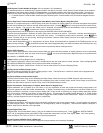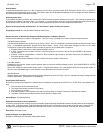
X GEM-P1664 Installation Instructions
L NAPCO Security Systems
WI1424A 1/06
Page 38
Lug E15 See "E" Lugs
Memory Failure
A User or Dealer Memory error will cause the sounder to pulse, the "
SYS/TRBL" reminder to flash, and the display to read "SYSTEM
TROUBLE/E19-00 SERVICE
" or "SYSTEM TROUBLE/E20-00 SERVICE". Press the C button to silence the sounder ("SYSTEM READY" will
display, along with the "SYS/TRBL" reminder). Activate RESET SYSTEM TROUBLE to manually reset the system trouble. A
Memory Failure can be programmed to activate an alarm output and/or report using its associated system Report Code.
Never Arm (Do not use for primary Burglary protection)
A zone programmed as "Never Arm" cannot go into alarm. If tripped, it will display at the keypad when the DISPLAY STATUS
function is selected. A chime will sound at the keypad while armed or disarmed if Chime is also programmed for that zone, and
enabled at the keypad. This feature is suggested for use as a garage-door or driveway monitor, or similar application.
No EOL Resistor
Program for any zone not wired with a 2200 Ohm end-of-line resistor. This will disable any zone-short indication (if programmed,
"Day Zone Short" is disabled). If not programmed, an end-of-line resistor must be installed. Note: This selection is automatically
disabled for zones selected as Fire. Note: Do not program for UL installations.
Number of Rings Before Pickup (Answer on Ring) See Callback-Method Download
One-Button Arming See Easy Arming
Opening Report; Opening Report Only After Alarm Report (Do not program for UL installations).
Opening and closing reports are generally used in commercial installations. On disarming, the communicator can send an Opening
Code for Users 1–64 (Opening Report), or it may transmit only when the control panel is disarmed after an alarm has been reported
(Opening Report Only After Alarm Report). (Note: Key Fobs 1–8 report as Users 57–64). Subscriber Identification Numbers and
Opening Codes must be entered for either opening report.
Program Opening Report Only After Alarm Report to report only when disarming after an alarm report. This feature may be used by
the central station to verify that the subscriber has responded and disarmed the panel. If "Opening Report Only After Alarm Report"
is selected, also select "Opening Report" for each user.
Panics; Keypad Aux Panic; Keypad (Police) Panic; Keypad Fire Panic See Fire; Remote Panic
The Panic Zone is always a 24-Hour Zone. Each keypad is individually selectable for keypad panics (see Keypad Features). If
"Keypad Panic" is programmed for a keypad, police panic is activated by simultaneously pressing the
9 and G buttons.
If "Keypad Aux." is programmed, pressing the 8 and G buttons simultaneously will trip an auxiliary emergency alarm. If
"Keypad Fire" is programmed, pressing the
7 and G buttons at the same time will activate fire panic.
A remote panic button may be connected to a GEM-RP2ASe2/K2AS and GEM-RP3DGTL/K3DGTL Keypad. Splice the two white
wires from the keypad to a normally-open momentary-contact pushbutton. Additional panic buttons may be wired in parallel with the
first. If remote panic will not be used, insulate both white wires, as a short across them will cause a panic alarm. (In UL installations,
remote-panic buttons must be located within 3 feet of the keypad, with no intervening walls or barriers.
Power-Up Delay
If programmed, power-up will be delayed for 5 minutes to allow devices such as PIRs time to stabilize (warm up). This will prevent
false alarms when ac power is restored after a long power outage and the backup battery is discharged. SIA CP-01 requires you
must program this feature on all zones with sensors.
Pre-Alarm Warning (Not for UL installations)
Programmable by zone, this feature will cause an alarm to sound only at the keypad for the duration of the programmed Abort Delay
(see Abort Delay; Time Selection). After the delay has elapsed, the alarm output will activate and a report will be sent. On a system
containing both interior and perimeter zones, the Pre-Alarm Warning will be active ONLY while the system is armed Stay (interior
zones bypassed). Tripping the perimeter zones activates an audible keypad warning before the alarm. If armed Away, ALL pre-
Alarm warning zones will cause an immediate alarm if tripped. Entry/Exit zones should not have Pre-Alarm Warning programmed.
On systems with perimeter zones only, the pre-alarm warning will always be active when the system is armed. To enable, select Pre-
Alarm Warning in Zone features and provide an Abort Delay Time of 0 to 254 seconds. Zero defaults to 10 seconds.
Pre-Dial Delay
A Pre-Dial Delay may be used whenever a delay is required before dialing. It may be required when programming Dial-Tone
Detection, which causes the communicator to wait before it attempts to detect a dial tone (see Dial-Tone Detection). Certain
telephone exchanges send a nonstandard dial tone that the communicator may not be able to detect. With these nonstandard
exchanges, it is possible to program Pre-Dial Delay rather than Dial-Tone Detection. This will cause the communicator to wait for a 4
second time period before dialing.Contact the telephone-equipment supplier to find out how long a delay is required before dialing.
Select "Pre-Dial Delay" by programming one "D" for each 4-second delay required immediately before the telephone number. In UL
Glossary


















